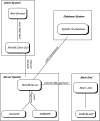Recent Hits Acquired by BLAST (ReHAB): a tool to identify new hits in sequence similarity searches
- PMID: 15701178
- PMCID: PMC549547
- DOI: 10.1186/1471-2105-6-23
Recent Hits Acquired by BLAST (ReHAB): a tool to identify new hits in sequence similarity searches
Abstract
Background: Sequence similarity searching is a powerful tool to help develop hypotheses in the quest to assign functional, structural and evolutionary information to DNA and protein sequences. As sequence databases continue to grow exponentially, it becomes increasingly important to repeat searches at frequent intervals, and similarity searches retrieve larger and larger sets of results. New and potentially significant results may be buried in a long list of previously obtained sequence hits from past searches.
Results: ReHAB (Recent Hits Acquired from BLAST) is a tool for finding new protein hits in repeated PSI-BLAST searches. ReHAB compares results from PSI-BLAST searches performed with two versions of a protein sequence database and highlights hits that are present only in the updated database. Results are presented in an easily comprehended table, or in a BLAST-like report, using colors to highlight the new hits. ReHAB is designed to handle large numbers of query sequences, such as whole genomes or sets of genomes. Advanced computer skills are not needed to use ReHAB; the graphics interface is simple to use and was designed with the bench biologist in mind.
Conclusions: This software greatly simplifies the problem of evaluating the output of large numbers of protein database searches.
Figures






Similar articles
-
Organizing and updating whole genome BLAST searches with ReHAB.Methods Mol Biol. 2007;395:187-94. doi: 10.1007/978-1-59745-514-5_11. Methods Mol Biol. 2007. PMID: 17993674
-
SS-Wrapper: a package of wrapper applications for similarity searches on Linux clusters.BMC Bioinformatics. 2004 Oct 28;5:171. doi: 10.1186/1471-2105-5-171. BMC Bioinformatics. 2004. PMID: 15511296 Free PMC article.
-
Windows .NET Network Distributed Basic Local Alignment Search Toolkit (W.ND-BLAST).BMC Bioinformatics. 2005 Apr 8;6:93. doi: 10.1186/1471-2105-6-93. BMC Bioinformatics. 2005. PMID: 15819992 Free PMC article.
-
The EMBL Nucleotide Sequence Database. Contributing and accessing data.Mol Biotechnol. 1999 Oct;12(3):255-67. doi: 10.1385/MB:12:3:255. Mol Biotechnol. 1999. PMID: 10631682 Review.
-
Finding homologs to nucleotide sequences using network BLAST searches.Curr Protoc Bioinformatics. 2002 Aug;Chapter 3:Unit 3.3. doi: 10.1002/0471250953.bi0303s00. Curr Protoc Bioinformatics. 2002. PMID: 18792938 Review.
Cited by
-
Approaching the taxonomic affiliation of unidentified sequences in public databases--an example from the mycorrhizal fungi.BMC Bioinformatics. 2005 Jul 18;6:178. doi: 10.1186/1471-2105-6-178. BMC Bioinformatics. 2005. PMID: 16022740 Free PMC article.
-
De novo assembly, transcriptome characterization, lignin accumulation, and anatomic characteristics: novel insights into lignin biosynthesis during celery leaf development.Sci Rep. 2015 Feb 5;5:8259. doi: 10.1038/srep08259. Sci Rep. 2015. PMID: 25651889 Free PMC article.
-
Re-searcher: a system for recurrent detection of homologous protein sequences.BMC Bioinformatics. 2008 Jun 27;9:296. doi: 10.1186/1471-2105-9-296. BMC Bioinformatics. 2008. PMID: 18588692 Free PMC article.
-
The Personal Sequence Database: a suite of tools to create and maintain web-accessible sequence databases.BMC Bioinformatics. 2007 Dec 18;8:479. doi: 10.1186/1471-2105-8-479. BMC Bioinformatics. 2007. PMID: 18088438 Free PMC article.
-
Java GUI for InterProScan (JIPS): a tool to help process multiple InterProScans and perform ortholog analysis.BMC Bioinformatics. 2006 Oct 20;7:462. doi: 10.1186/1471-2105-7-462. BMC Bioinformatics. 2006. PMID: 17054794 Free PMC article.
References
Publication types
MeSH terms
Substances
Grants and funding
LinkOut - more resources
Full Text Sources
Research Materials
Miscellaneous

